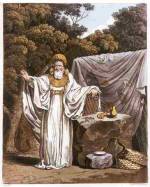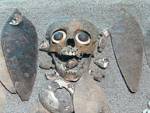The Old Ways
 OOC Note: The majority of these Gods only borrow bits from history, and much is made up wholesale. Do not rely on any OOC knowledge you may have!
OOC Note: The majority of these Gods only borrow bits from history, and much is made up wholesale. Do not rely on any OOC knowledge you may have!
The cathedrals and abbeys dedicated to the great Gods and saints of Christendom may dominate the landscape and hearts of the nation, but in some places the old ways are still honoured. Chanting is still heard around ancient megaliths dedicated to forgotten Gods. The honoured ancestors still linger in the barrows for those who know how to call upon their power. At the edges of society priests of the old religion still tend their faithful.
Heathens!
![By mullica [CC BY 2.0 (http://creativecommons.org/licenses/by/2.0)], via Wikimedia Commons By mullica [CC BY 2.0 (http://creativecommons.org/licenses/by/2.0)], via Wikimedia Commons](/_media/witch_burning.jpg?w=200) Anyone who openly worships the false Gods belonging to primitive beliefs is a heathen! Their soul is in peril and all God-fearing Christians should work towards their redemption and acceptance of Christ as the One True God. Should such heathens demonstrate supposed “miracles” in support of their false Gods, it is clear they have either been deceived by an evil spirit.
Anyone who openly worships the false Gods belonging to primitive beliefs is a heathen! Their soul is in peril and all God-fearing Christians should work towards their redemption and acceptance of Christ as the One True God. Should such heathens demonstrate supposed “miracles” in support of their false Gods, it is clear they have either been deceived by an evil spirit.
It is said that the remnants of the old faiths are strongest in the Wilds, hiding deep in fen and wood, mountain and moor where they can continue their foul practice in relative peace. Yet many sites of ancient power lie within civilized lands, and from time to time accounts circulate of their recent use. Indeed for those who track such things, it seems if anything the number of pagan rites has increased in recent years.
Worship
The correct forms of worship for particular deities are for the most part lost knowledge by now, jealously guarded by their followers lest they be persecuted further. Common folklore holds that heathen Gods require blood sacrifice and adherence to other unclean and heretical pratices, and that in return demonic power is granted to their priests. Of course common folklore also holds that hanging horseshoes upside down/on their side/rightways up will bring bad luck.
Major Heathen Cults
Druidism - Old Gods of the Celts
 The druids were the ancient priestly class of the Celts. They took upon themselves the role of relating to the Gods upon behalf of their people, thanking them for their benevolence or bringing down their wrath as the situation warranted. Famed for their innate understanding of nature, they have been cast as archetypal nature worshippers, though this is far from the truth in most cases — unless such is demanded by the local God. It is said that the celtic Gods loved their internal politics, and their downfall against Christianity may have had more to do with their incessant squabbling than any advantage Christendom had to bring. This is, of course, nonsense.
Many Druidic remnants still persist in the wilder areas of Scotland, Wales, Cornwall and the northern parts of France.
The druids were the ancient priestly class of the Celts. They took upon themselves the role of relating to the Gods upon behalf of their people, thanking them for their benevolence or bringing down their wrath as the situation warranted. Famed for their innate understanding of nature, they have been cast as archetypal nature worshippers, though this is far from the truth in most cases — unless such is demanded by the local God. It is said that the celtic Gods loved their internal politics, and their downfall against Christianity may have had more to do with their incessant squabbling than any advantage Christendom had to bring. This is, of course, nonsense.
Many Druidic remnants still persist in the wilder areas of Scotland, Wales, Cornwall and the northern parts of France.
Blood & Bone - The Ancient Ways
 The lands of England are littered with ancient megalithic structures. The Long Barrows, The Henges, Cairns, Chalk figures. Their purpose is lost to history, what is clear is the great effort required for their construction. Some modern masons claim they would be impossible to reproduce even with modern technology. After a long absence, it has become clear that these structures are being used once more by parties unknown.
The lands of England are littered with ancient megalithic structures. The Long Barrows, The Henges, Cairns, Chalk figures. Their purpose is lost to history, what is clear is the great effort required for their construction. Some modern masons claim they would be impossible to reproduce even with modern technology. After a long absence, it has become clear that these structures are being used once more by parties unknown.
Saints vs Heathen Deities
Some scholars have observed that many saints bear some similarity to some of the old gods, and that many of the same affectations are used in their worship. It is well known among men of learning that this is merely an artefact of the way missionaries originally saved the heathens. The official church line is that the act of worship and acceptance of Christ the Saviour is more important than the form thereof.
Playing a Follower of the Old Ways
- At the time of character creation tell us who you worship. If you take the Faith skill, you can specialise in a particular God.
- Pagan players will have access to a secret brief giving them details of appropriate forms of worship.
- Note the quirks Heathen Upbringing and Known Heretic!
- You may also wish to consider joining the Inheritors of the Old Ways faction.
- However, be aware that should your heathen ways become known to others, they may well find your lack of faith disturbing.
